These are the 2023 Modernism in America Awards winners
By Josh Niland|
Friday, Sep 15, 2023

Related
Docomomo US is back again with its 2023 Modernism in America Awards winners. Projects from nine states and the District of Columbia received seven Awards of Excellence and six Citations of Merit in the program's tenth edition, to which Los Angeles-based architect Barbara Bestor served as jury chair.
“These projects are beacons of inspiration, showcasing the transformative power of preserving and reusing Modern sites. I am so proud to be able to honor more projects that celebrate the rich culture and heritage of Black and underrepresented communities,” Liz Waytkus, the organization’s Executive Director, said in summation.
“This year's Modernism in America Awards celebrate the ongoing journey of Modern preservation. These projects not only reveal the richness of our Modern heritage but also serve as catalysts for fostering creativity, sustainability, and inclusive design in our ever-evolving built environment,” Docomomo US Board Member Meredith Arms Bzdak added.
The 2023 Awards will be presented on Thursday, November 2, at the Design Within Reach Third Avenue Showroom in New York City. The full list of winning projects can be found below.
DESIGN AWARDS OF EXCELLENCE

Samara: The John and Catherine Christian House
Location: West Lafayette, IN
Original architect: Frank Lloyd Wright
Project Team: General Contractor: Brandt Construction, Inc. (Clint Cravens, Project Manager; Andy Sipe, Superintendent); Architects: Harboe Architects (Gunny Harboe, FAIA; Bob Score, AIA); Structural Engineer:1200 Architectural Engineers (John Matteo, PE, FAAR); MEP Engineer: Architectural Consulting Engineers (Mark Nussbaum, PE); Architectural Conservator: Building Conservation Associates (Dorothy Krotzer)
Jury comments: "A Residential Design Award of Excellence is given for the restoration of Samara: The John and Catherine Christian House. Completed in 1956, the home is a remarkable embodiment of Frank Lloyd Wright's Usonian design principles. Having attained National Historic Landmark status in 2015, a crucial $500,000 Save America's Treasures Grant was secured from the National Park Service, enabling Indiana Landmarks, co-steward of the property, to undertake a meticulous rehabilitation. Harboe Architects, renowned for their expertise in preserving Wright-designed properties, led the restoration with a keen eye for maintaining the integrity of the original structure. Challenges included stabilizing the terrace and lanai wall, salvaging and reusing original pavers, and adapting living room ductwork while respecting the original design. Attention to detail, adherence to historic preservation standards, and dedication to matching materials were paramount in the success of this endeavor. When so many Modern homes of a similar scale are being torn down or inappropriately altered, this successful restoration exemplifies a deep commitment to architectural heritage, guarantees structural integrity for future generations and allows visitors to once again enjoy the terrace and lanai during public tours. Jury chair Barbara Bestor commended the 'detailed documentation of the restoration process and special care that were taken every step of the way.'"
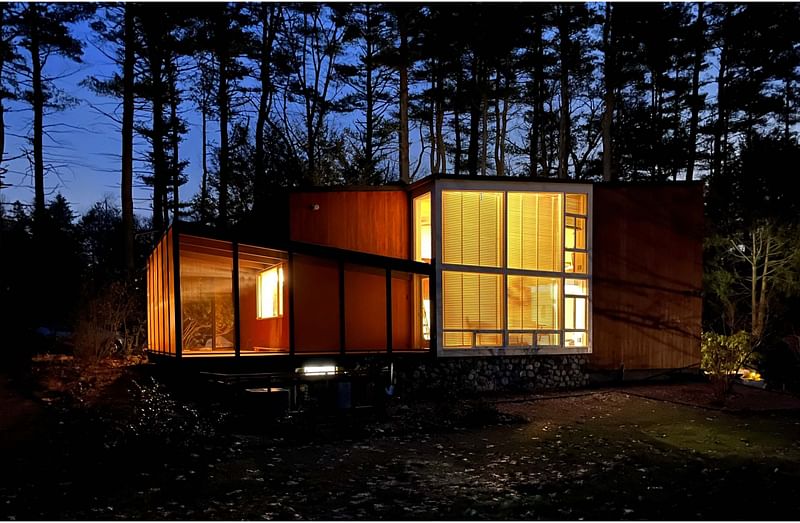
Schwann House and Studio
Original Architect: Walter Bogner
Location: Lincoln, MA
Project Team: Andersen Miller Design
Jury comments: "A Residential Design Award of Excellence is given for the restoration of the Schwann House and Studio, completed in 1947 by Walter Bogner, who played a key role in bringing Modern architecture stateside and shaping New England's midcentury architectural landscape. Commissioned by William Schwann, renowned musician and publisher of the Schwann Catalog, the property was incorporated into the Lincoln, MA historic district in 2022. The Schwann House epitomizes Bogner's architectural brilliance, blending simplicity and functionality, with large windows blurring the lines between indoor and outdoor spaces. A notable feature is Bogner's innovative window frame profile, central to the restoration's focus, reflecting his commitment to form and function. The layout, characterized by a stone fireplace and captivating sculptural elements, creates an inviting ambiance for live music and refined living. The restoration aimed to return the house to its 1948 state while preserving the original floor plan, millwork, hardware, and fixtures, and introducing subtle modernizations. Key changes include added bathrooms and improved connectivity between spaces for enhanced livability without compromising the original design. Bogner’s original color palette was painstakingly revived, drawing inspiration from nature and the site's organic hues."
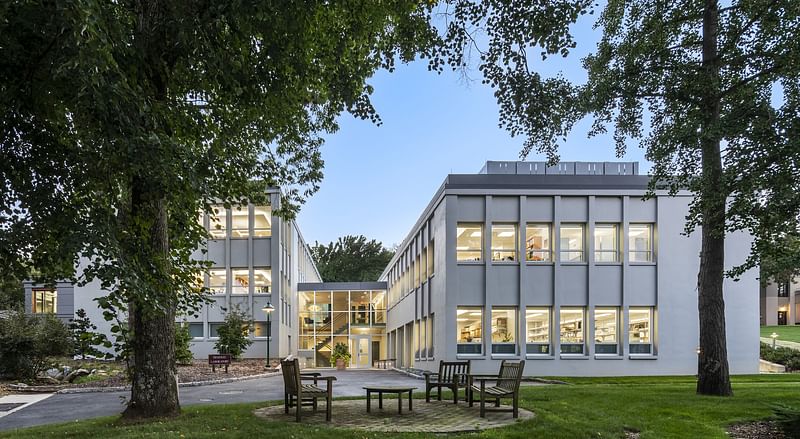
Demerec Laboratory, Cold Spring Harbor Laboratory
Location: Cold Spring Harbor, NY
Original Architect: Anderson and Beckwith
Project team: Centerbrook Architects and Planners (Todd Andrews, AIA, Principal; Reno Migani, AIA, Project Manager; Aaron Trahan, AIA, Architect; Ken Cleveland, AIA, Architect); Craig Razza, PE, Partner, Kohler Ronan Consulting Engineers, MEP Engineer; Scott Erricson, PE, Principal, e2 Engineers, Structural Engineer; Bernard R. Fortunato Jr., President, Fortunato Sons Contracting, Contractor; Jim Mcilwee, Project Manager, Fortunato Sons Contracting, Contractor; Dr. Bruce Stillman, President, Cold Spring Harbor Laboratory, Owner
Jury comments: "A Civic/Institutional Design Award of Excellence is given for the restoration of Demerec Laboratory and Cold Spring Harbor Laboratory, a historic scientific landmark that played a pivotal role in the advancement of genetics research. Established in 1890 as a collaborative endeavor between the Brooklyn Institute of Arts and Sciences and the Carnegie Institute of Washington, Cold Spring Harbor Laboratory evolved over time into a renowned scientific institution. In 1953, the visionary 16,000-square-foot Demerec Laboratory was completed, designed by Anderson and Beckwith, known for their pioneering work at MIT. Embodying a Modernist style, Demerec Laboratory stood in stark contrast to the historic whaling village surrounding it. Its innovative design, with cast-in-place concrete structures nestled into a hillside and a glass connector providing panoramic views, is a testament to scientific and architectural innovation. The project team worked closely with the State Historic Preservation Office to identify, retain and restore character-defining elements, many of which were obscured by past modifications. The interior was stripped back to its concrete structure, the laboratory layouts were reconfigured to provide direct connections to the landscape, and modern building systems were installed to support high-level molecular biology and chemistry research in the historic eleven-foot floor-to-floor structure. The glass connector and ornamental staircase were meticulously restored, and the exterior was coated to match the original concrete. A new three-story addition harmoniously complemented the historic structure, maintaining the rhythm of structure and window openings. Today, Demerec Laboratory, renamed the Center for Therapeutics Research, stands as a symbol of architectural and scientific excellence, contributing to pioneering biochemistry research and preserving its legacy as a cornerstone of Cold Spring Harbor Laboratory."
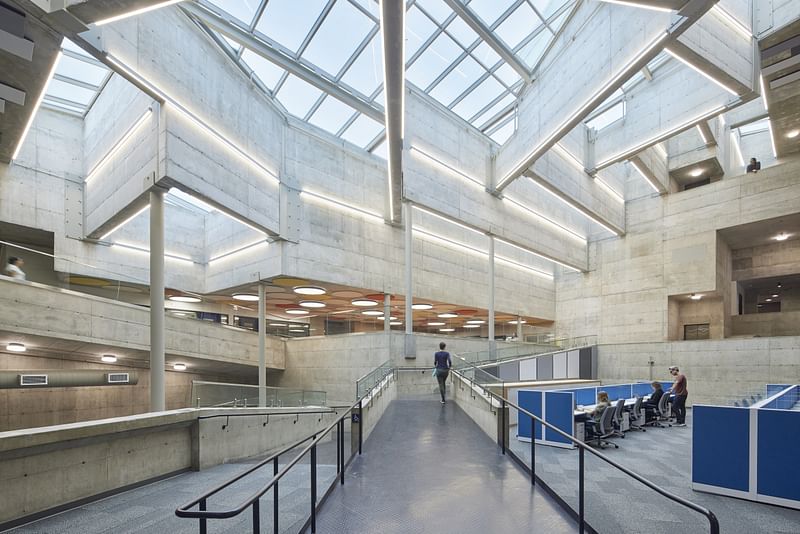
Bakar BioEnginuity Hub
Location: Berkeley, CA
Original Architect(s): Mario Ciampi and associates Richard L. Jorasch and Ronald E. Wagner
Project team: MBH Architects
Jury comments: "A Civic/Institutional Design Award of Excellence recognizes the restoration of the Bakar BioEnginuity Hub, a project that ingeniously revitalized a celebrated architectural treasure. Originally the Berkeley Art Museum & Pacific Film Archive, designed by Mario Ciampi, Richard L. Jorasch and Ronald E. Wagner, it earned acclaim upon its 1970 opening for its Brutalist design featuring staggered Cubist masses, a soaring atrium, and sculptural forms. However, in 1997, structural concerns cast doubt on its future, prompting fears of demolition. After years of uncertainty, a visionary partnership emerged in 2016 between the University of California, Berkeley, and Bakar Labs. Their goal was to preserve the building's historical significance while reimagining it as a cutting-edge life science hub, fostering collaboration among students, startups, and biotech firms. The restoration encountered formidable challenges due to the building's unique geometry and all-concrete structure. Studies were conducted to safeguard its character-defining elements. An expansion beneath the cantilevered upper galleries offered additional space without compromising the original structure. Seismic retrofitting, infrastructure modernization, and a shift to all-electric systems ensured code compliance and operational carbon neutrality. The Bakar BioEnginuity Hub, unveiled in 2022, serves as an important epicenter for life science innovation. It preserves an architectural legacy and provides researchers with an inspiring backdrop for groundbreaking endeavors."
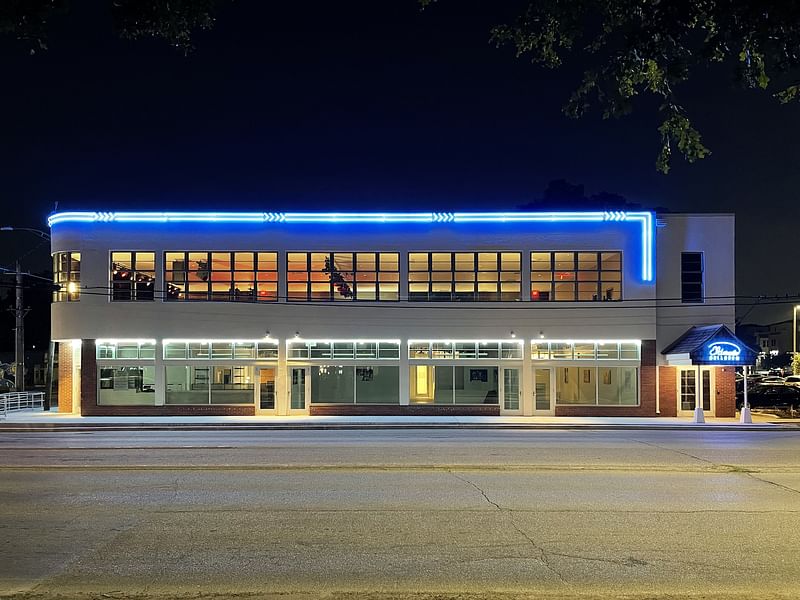
Eldorado Ballroom
Location: Houston, TX
Original Architect: Lenard Gabert
Project Team: Stern and Bucek Architects (Architect); Ward, Getz and Associates (Civil Engineering); LTY Engineers (MEP Engineering); Charles D. Gooden Consulting Engineers (Structural Engineering); Ulrich Engineers, Inc. (Geotechnical Engineering); Apollo BBC (Building Science Engineering); Lauren Griffth Associates (Landscape Architect); S.L Anderson Company (Arborist); Cleve Tuttle (Graphics & Tenant Design)
Jury comments: "A Commercial Award of Excellence is given for the restoration of the Eldorado Ballroom, a Streamline Moderne style building completed in 1939 by architect Lenard Gabert. This project resurrects a vital piece of African American cultural history in Houston's Third Ward, honoring its legacy as the premier destination for live music and celebrations for Houston’s Black community during the Jim Crow era. Established in 1939 by Anna and Clarence Dupree, the Eldorado Ballroom helped shape the careers of local and national artists, hosting legendary musicians like Arnett Cobb, Johnny "Guitar" Watson, and Jewel Brown. In the early 1970s, after three hopping decades, tensions with police, a changing musical scene, and newly desegregated venues led the Ballroom to close. In 1999, it was gifted to Project Row Houses, a community platform that enriches lives through art with an emphasis on cultural identity and its impact on the urban landscape. After partial renovations, it reopened as a rental event space in 2003. A full restoration began in earnest in 2020, despite general uncertainty caused by the Covid-19 pandemic. Work included preservation of the exterior stucco and brick, restoring historic finishes and windows, and introducing custom aluminum windows to match historic profiles. The interior spaces were sensitively updated with new wood paneling and a historic-influenced bar. An accessible rear addition, enhanced parking facilities, and landscaped outdoor spaces, were seamlessly integrated."
INVENTORY/SURVEY AWARD OF EXCELLENCE
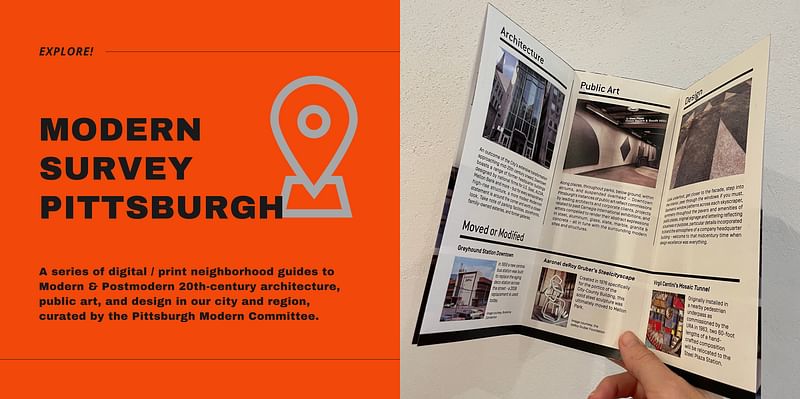
Modern Survey Pittsburgh
Location: Pittsburgh, PA
Project Team: Pittsburgh Modern Committee and Preservation Pittsburgh (Producers); Brittany Reilly (Committee Chair, Project Manager, Photographer) with Pittsburgh Modern Committee members and network (Research & Review Team); Nina Zagorscak (Graphic Designer); Tri-State Signs & Reprographics, Inc (Printer)
Jury comments: "An Inventory/Survey Award of Excellence is given for the innovative Modern Survey Pittsburgh project. This ongoing initiative provides accessible print and digital maps that document Greater Pittsburgh's 20th-century Modern and Postmodern architecture, design, and public art, making it a valuable educational resource. Each map focuses on a specific walkable neighborhood area, showcasing around 20 significant structures, including corporate buildings, schools, churches, residential spaces, and more, dating from 1945 to 1990. These maps aim to engage users of all architectural knowledge levels by highlighting the diversity of Pittsburgh's design landscape in the second half of the 20th century. Each pamphlet provides historical context and when appropriate highlights sites that have undergone significant modifications or relocations to acknowledge the changing dynamics of neighborhoods. Printed maps are distributed at local bookshops and events, while digital versions are accessible on the Pittsburgh Modern Committee's website and Instagram. The project, made possible by dedicated volunteers and generous donations, has gained substantial engagement and positive feedback, fostering awareness and appreciation of Pittsburgh's Modern architectural heritage."
ADVOCACY AWARD OF EXCELLENCE

Ebony Test Kitchen
Location: Chicago, IL/Washington, DC
Original Designers: William Raiser and Arthur Elrod (kitchen design); John Moutoussamy (architect)
Project Team:
Landmarks Illinois (Frank Butterfield, Lisa DiChiera, Kaitlyn McAvoy, Bonnie McDonald); Skyline Council of Landmarks Illinois and volunteers (Justin Barnes, Susanna Craib-Cox, Eric Dexter, Jill Dexter, Chris Enck, Lauren Garvey, Monica Giacomucci, Michael Johnson, Rachel Leibowitz, Chelsea Medek, Gloria Moy, Lewis Purdy, Anthony Rubano, Erica Ruggiero, Laura Schuetz, Matt Seymour, Meredith Morgan Stuart); Ebony Test Kitchen Advisory Panel (Adele Cygelman, Chris Enck, Graham Grady, Ra Joy, Yvette LeGrand, Nathan Mason, Eric T. McKissack, Langdon Neal, Angelique Power, Sandra Rand, Joseph W. Slezak, Amanda Williams); Lee Bey (formerly of the DuSable Black History Museum and Education Center); Chris Enck (Revive Architecture); Joe Slezak (3L Real Estate); Museum of Food and Drink (Peter Kim, Nazli Parvizi, Catherine Piccoli, Jean. Nihoul); Smithsonian National Museum of African American History and Culture (Kevin Young, Joanne Hyppolite, Ph.D.
Jury comments: "An Advocacy Award of Excellence is given for the outstanding efforts to save the historic Ebony Test Kitchen. Used for decades by Ebony Magazine food editors, the Test Kitchen is a significant part of the legacy of Johnson Publishing Company, the nation's foremost African American publisher during its prime. Originally housed within the Publishing Company’s headquarters, itself a Chicago Landmark designed by John Moutousammy, the first Black architect to have a building on Michigan Avenue, the Test Kitchen got its signature funky aesthetic with the help of Palm Springs-based interior designers William Raiser and Arthur Elrod. In 2018, as the building faced redevelopment, Landmarks Illinois secured the Test Kitchen's future by purchasing it for $.1With the aid of dedicated volunteers and the Skyline Council, it was documented, dismantled, and stored until the following year when it went on loan at the Museum of Food and Drink (MOFAD), which reconstructed two rooms, refurbished the kitchen, and reproduced key elements, including its iconic wallpaper, for the exhibition African/American: Making the Nation’s Table."
CITATIONS OF MERIT
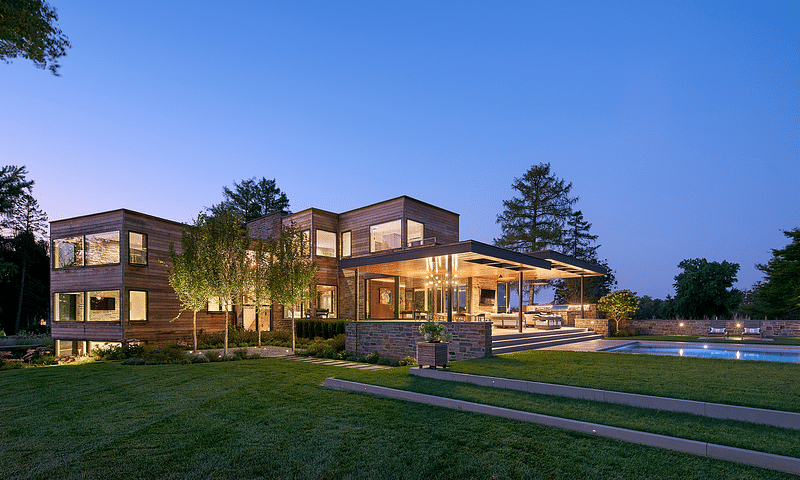
Birch Knoll
Location: Newtown Square, PA
Original Architect: George Daub
Project Team: Architecture/Interior Design: k YODER design (Kevin Yoder, AIA, LEED AP); Construction: Baroni Building Company (Bud Baroni); Landscape Design: Hess Landscape Architects (Jason T. Kelso, RLA); Home Automation: Springboard Automation (Everett Katzen); Structural Engineering: Innovative Structural Engineers (Timothy Beaver, PE); Custom Cabinetry and Millwork: Craft-Maid (Dave Kershner); Photography: Jeffrey Totaro
Jury comments: "A Residential Design Citation of Merit is given for the restoration of Birch Knoll, designed by Philadelphia architect George Daub in 1949. Initially built for the President of Aronomink Golf Course, Birch Knoll occupies a picturesque spot alongside the 14th and 15th holes, showcasing its International Style design with panoramic views through expansive windows and an asymmetrical layout, blending glass, steel, stone, and wood. After years of neglect following a 2011 renovation, Birch Knoll found new custodians in 2017 who aimed to restore its original Midcentury Modern appeal. Lacking original drawings, in-depth research and selective demolition were conducted to ensure design interventions aligned with Daub's vision. The building envelope was a significant challenge, necessitating a complete overhaul to prevent water infiltration and restore the natural wood finish. The use of natural stone, walnut millwork, and faithful replication of original elements helped address material inconsistencies. Technological advancements were integrated without compromising the design intent. Birch Knoll's restoration ensures the residence remains a timeless and comfortable family home, ready for 21st-century living."
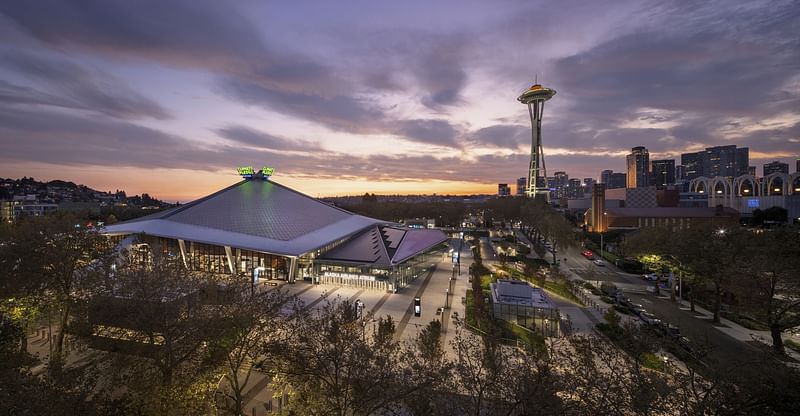
Climate Pledge Arena
Location: Seattle, WA
Original Architects: Paul Thiry and NBBJ
Project Team: Architect of Record: Populous; General Contractor: Mortenson; Structural Engineer: Thornton Tomasetti; Preservation Consultant: Historic Resources Group; Local Architect: DLR Group; MEP Engineer: ME Engineers; Landscape Architect: Swift Company; Owner’s Representative/Project Manager: CAA ICO
Jury comments: "A Civic/Institutional Design Citation of Merit is given for the restoration of Climate Pledge Arena. This historic arena, originally the Century 21 - Washington State Coliseum, played a pivotal role during the 1962 Century 21 Exposition. Designed by Paul Thiry, it showcased innovative architectural feats, including its massive clear-span structure and distinctive glass curtain walls. Over time, the arena faced obsolescence, but it was saved through creative adaptive reuse. To accommodate modern needs, a new atrium lobby and entrance plaza were constructed on the south side, offering a transparent and visually minimal addition. The interior was completely reimagined, with the event floor lowered and a regulation-size arena installed. Notably, the historic concrete buttresses, perimeter piers and glass curtain wall were preserved during excavation and construction. The project adhered to the Secretary of the Interior's Standards for Rehabilitation, utilizing federal tax credits. Today, Climate Pledge Arena stands as one of the largest and most iconic structures from the Century 21 Exposition, retaining its distinctive profile and serving as a prominent landmark in Seattle."
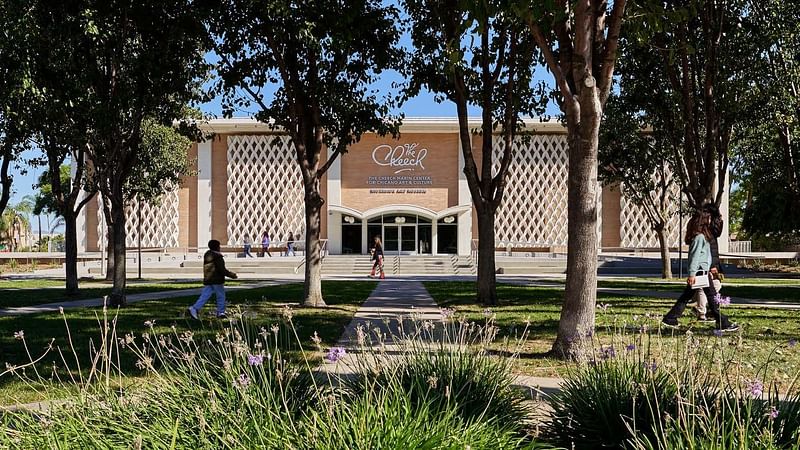
The Cheech Marin Center for Chicano Art & Culture
Location: Riverside, CA
Original Architect: Moise, Harbach and Hewlett
Project Team: Page & Turnbull (Architect of Record, Preservation Architect); wHY Architects (Design Architect); Structural Focus (Structural Engineer); Design West Engineering (MEP Engineer); HLB Lighting Design (Lighting Designer); Lerch Bates (Elevator Consultant); Epic Engineers (Civil Engineer); Teecom (Security, A/V & IT Consultant); Jenny Huang Design (Signage Consultant); Veneklasen Associates (Acoustic Consultant); Hamel Contracting Inc (Contractor)
Jury comments: "A Civic/Institutional Design Citation of Merit is given for the restoration of the Cheech Marin Center for Chicano Art & Culture. Through a public-private partnership, this project creatively reimagined a decommissioned midcentury library into a unique cultural hub, celebrating Chicano art and culture while preserving its New Formalist architectural essence. Situated in Riverside's historic downtown, The Cheech revolves around Cheech Marin's collection of over 500 Chicano artworks and raises awareness that 'Chicano art is American art.' The project utilized 'acupuncture architecture,' strategically enhancing visitor experiences. Significant design decisions included converting the reading room into galleries, incorporating modern systems and lighting, and creating a zócalo, or town square, in the former lobby. A striking double-volume space was fashioned by opening up the second floor, allowing for a site-specific lenticular mural by artists Einar and Jaime de la Torre. The grand staircase was fully restored, the façade was refurbished, and the original entrance podium level was restored to its former prominence, now hosting various activities. Key details such as the red brick walls and plaster domes, were retained."
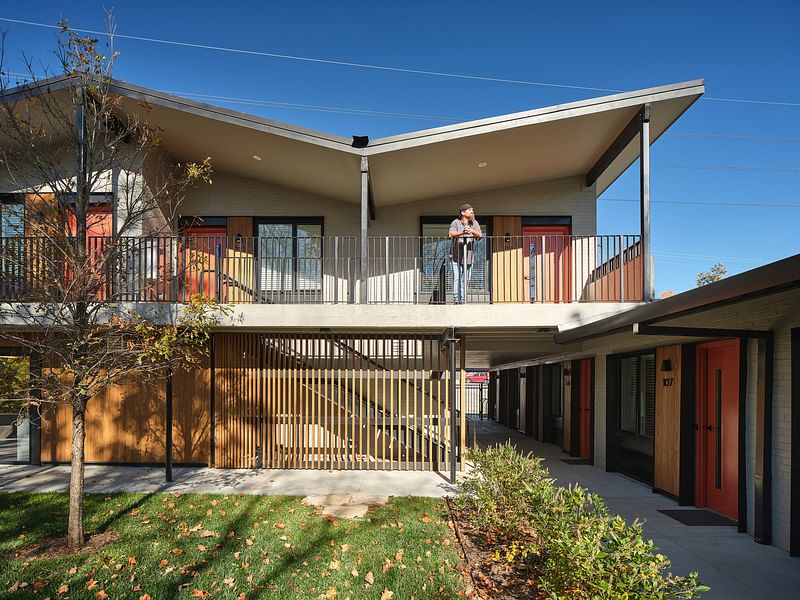
Dogan-Gaither Flats
Location: Knoxville, TN
Project Team: Sanders Pace Architecture (John L. Sanders, FAIA, Aaron L. Pennington, Assoc. AIA, Cameron Bolin, AIA, Tyler Sanford, Assoc. AIA, Lindsay Clark Assoc. AIA); Mallia Engineering Company (Structural Engineering); Engineering Services Group (MEP Engineering); Will Robinson & Associates (Civil Engineering); QE2 – Quantum Environmental & Engineering Services (Environmental Engineering); Hedstrom Landscape Architecture (Landscape Architecture)
Jury comments: "A Commercial Design Citation of Merit celebrates the restoration and adaptive reuse of Dogan-Gaither Flats: Valor Way. This project revives an important piece of Knoxville's African-American business history, transforming a midcentury motel into permanent, supportive housing while preserving its iconic design. The motel’s culturally rich history is paramount. When brothers A.D. 'Jake' and A.S. 'Big Jake' Gaither opened Dogan-Gaither Courts in 1957 in its original Vine Avenue location, it was the first Black-owned motel in Knoxville. It was listed in the Nationwide Hotel Association Directory and Guide to Travelers, a rival publication to the Green Book. The name Dogan refers to Nathan Dogan, long-time head bellman at the historic Hotel Farragut. His daughter, Dorothy, was Jake Gaither’s wife and manager of the motel. Dorothy spearheaded the move to Jessamine St in 1963, when an urban renewal project to construct the James White Parkway destroyed the 'heart of the Negro business district,' forcing them to relocate. In its heyday, the motel hosted famous patrons such as Ray Charles and Cab Calloway, as well as Freedom Riders on a courageous journey through the Deep South. In later decades, it became vacant and fell into disrepair. Fourth Purpose Foundation, under the leadership of Josh and Tracy Smith, embarked on the renovation, with a mission to transform lives by offering a safe and resource-rich environment to formerly incarcerated individuals. The project thoughtfully preserved and enhanced the building's midcentury design elements, including its butterfly-shaped inverted roof form and exterior entrances. Original breezeways were reactivated, reconnecting the courtyard and allowing user-controlled access. The restoration used the layout of the original motel rooms as a starting point for design of the new program. The exterior spaces were thoughtfully landscaped to create a welcoming community environment, making Dogan-Gaither Flats a testament to revitalization, community engagement, and historic preservation."

Jackson Lake Lodge
Location: Moran, WYOriginal Architect: Gilbert Stanley Underwood
Project Team:
Architect: HPZS (April Hughes, Principal in Charge; Henry Zimoch, Project Manager; Andrea Sforza, Project Architect; Caryssa Buchholz, Associate Architect); Engineer: Nelson Engineering (Ryan Simmons, Project Engineer; Canyon Huber, Engineering Technician); Painting Consultant: Beeck Mineral Paints (Tom Tipps, Product Specialist); General Contractor: Bulley & Andrews Concrete Restoration (Don Redar, Vice President; Tim Redar, General Superintendent; James Masterfield, Assistant Project Manager; Reyes Rodriguez, Project Foreman)
Jury comments: "A Commercial Design Citation of Merit is given for the restoration of Jackson Lake Lodge, located within Grand Teton National Park. The Lodge was designed for John D. Rockefeller, Jr. who intended it to be a 'pilot project' for the introduction of the Post-war Modern aesthetic into the National Parks. Upon completion in 1955, architect Gilbert Stanley Underwood’s visionary design changed public perceptions on appropriate settings for Modern architecture. Ultimately, it became the precursor for the Mission 66 building program. By 2020, the lodge was showing the effects of climate extremes. Additions and renovations had also altered some of the historic characteristics. The façade, composed of a distinctive textured concrete finish known as 'Shadowood,' was meticulously restored, matching original forms and finish texture. Due to the characteristics of aged concrete, the original acid stain could not be recreated. Building upon research by University of Pennsylvania graduate students and professors, a successful three-coat silicate glaze process was developed to replicate the concrete’s original appearance. To maintain uniformity, two painters applied the entire 75,000 square feet of finish. A roof replacement and recoating of the promenade deck over the porte cochere were also included in the project. The team overcame many challenges, including a remote location, difficult and often uncooperative climate, and a requirement that the lodge remain open throughout the restoration. Jackson Lake Lodge can now be appreciated as originally intended by its over three million annual visitors."
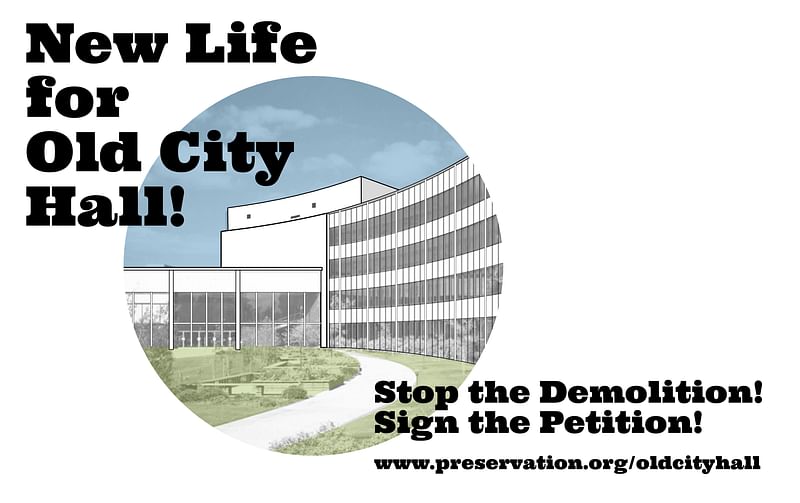
Former San Jose City Hall
Location: San Jose, CA
Project Team: Preservation Action Council of San Jose (PAC*SJ); Omgivning; Swinerton; Degenkolb Engineers; Architectural Resources Group; Docomomo US/Northern California
Jury comments: "The jury awards an Advocacy Citation of Merit for the exceptional efforts to save the Former San Jose City Hall, led by the Preservation Action Council of San Jose (PAC*SJ) and its partners. Designed by architect Donald Francis Haines and completed in 1958, this five-story, 113,000-square-foot building is an early example of International Style civic architecture on the West Coast. After years of vacancy and ownership changes, it was facing potential demolition. PAC*SJ, in collaboration with local stakeholders, embarked on an extensive advocacy campaign. They effectively elevated public awareness of its historical significance, emphasizing its association with pioneering mayors Norman Mineta and Janet Gray Hayes. A targeted letter-writing campaign and public petition garnered over 300 signatures, highlighting the community's support for preservation and adaptive reuse. To address challenges related to the County's 'infeasibility analysis,' PAC*SJ enlisted a team of experts led by Omgivning, who provided an alternative redevelopment proposal. Their efforts culminated in a crucial Board of Supervisors vote, resulting in a decision to reject demolition plans and explore reuse options."

RELATED NEWS Rethinking a 'culture of disposability': Docomomo US names 2022 Modernism in America Awards winners

RELATED NEWS Docomomo US announces 2021 Modernism in America Award winners


Share
2 Comments
sfgodbee · Sep 18, 23 6:59 PM
It appears the photo for Jackson Lake Lodge is currently being used for Dogan-Gaither Flats.
Archinect · Sep 18, 23 8:26 PM
@sfgodbee Thank you for catching that. We have corrected the article.
Comment as :